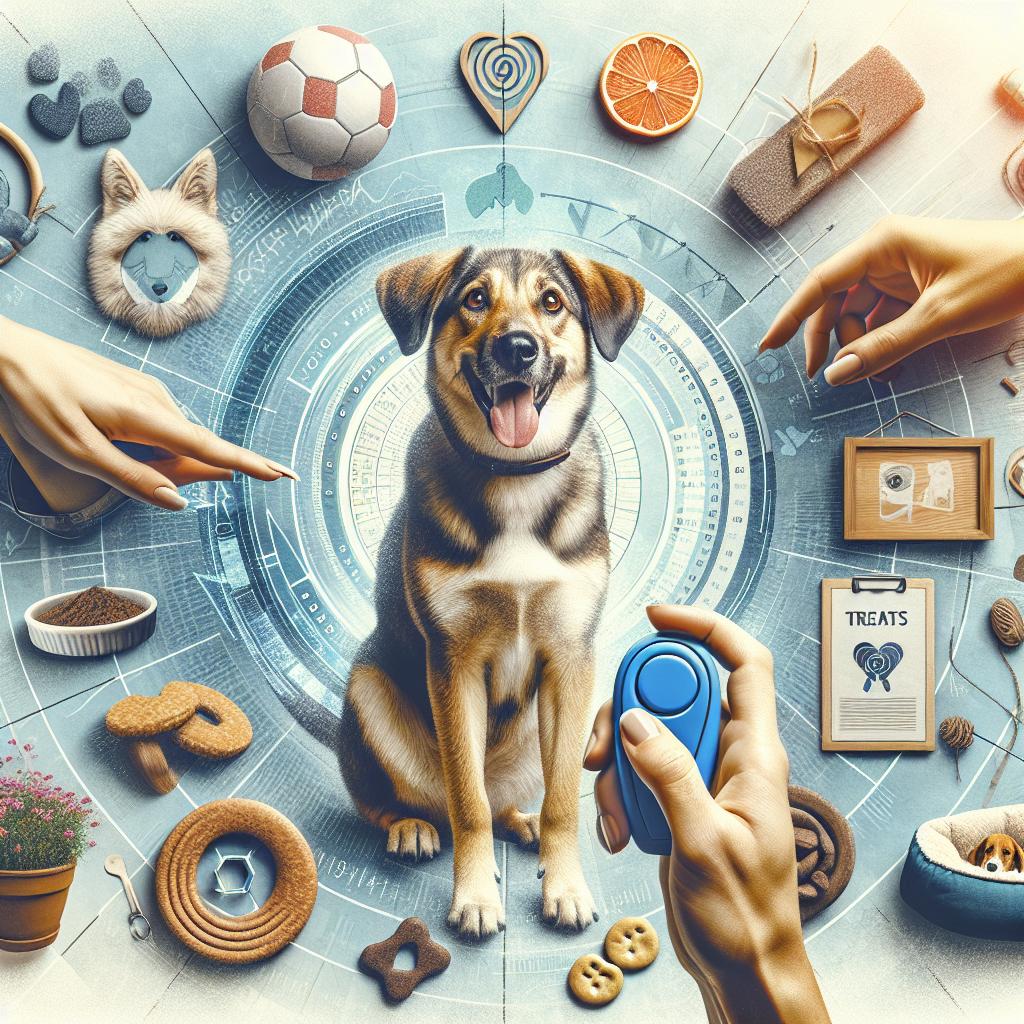Introduction: Harnessing the Power of Positive Reinforcement for Shy Dogs
In a world bustling with sounds and sights, the shy dog stands out as a gentle soul, quietly observing from the sidelines. Whether it’s a timid pup cowering at the sight of a stranger or a reserved rescue still finding its footing in a new home, these sensitive canines often need a little extra support to flourish. Traditional training methods can be overwhelming for dogs who thrive on patience and understanding. Enter positive reinforcement – a powerful, compassionate approach that taps into the innate desire to please and encourages confidence in our furry companions. This article explores effective strategies for using positive reinforcement to transform the timid into the adventurous, helping your shy dog blossom into the vibrant personality waiting to emerge. Join us as we delve into tailored methods that celebrate progress, build trust, and strengthen the bond between you and your four-legged friend.
Understanding the Shy Dog: Recognizing Fear and Anxiety Triggers
Understanding the behavior of a shy dog is essential for successful training and socialization. These dogs can exhibit fear and anxiety in various situations, often leading to behaviors such as withdrawal, avoidance, or even aggression. Identifying the triggers that make your dog anxious is the first step in helping them gain confidence. Common fear and anxiety triggers may include:
- Strange noises, such as thunderstorms or fireworks
- New people or other animals
- Unfamiliar environments
- Certain movements, like loud clapping or sudden gestures
When you become aware of what specifically causes your dog distress, you can take deliberate steps to lessen their anxiety. Implementing gradual exposure to these triggers in a controlled manner can be beneficial. It is important to create a positive association with these fearful stimuli, which can be achieved by using treats and praise when your dog responds calmly. Consider maintaining a behavior log to track your dog’s reactions and improvements over time. Here’s a simple table to help you monitor some behaviors and progress:
| Trigger | Initial Reaction | Progress (1-5) |
|---|---|---|
| Stranger Approaching | Barking & Shrinking Away | 3 |
| Thunder Sound | Hiding | 2 |
| New Animal | Growling | 4 |

Building Trust: Creating a Safe and Supportive Environment
To cultivate an atmosphere that encourages your shy dog to thrive, it’s essential to establish a foundation of trust. Start by introducing your furry friend to their surroundings at a comfortable pace. Minimize overwhelming stimuli such as loud noises or sudden movements, allowing your dog to explore their environment without pressure. Utilize positive reinforcement techniques, such as offering treats or praise for small steps taken toward bravery. This approach fosters a sense of security and helps your dog associate their surroundings with positive experiences.
| Positive Reinforcement Strategies | Expected Outcomes |
|---|---|
| Offering a favorite treat | Increased enthusiasm during training |
| Gentle encouragement | Enhanced confidence |
| Playtime rewards | Stronger bond between dog and owner |
Moreover, ensure that your interactions are consistent and patient. Employ a calm voice and reassuring body language to convey safety. Celebrate your dog’s successes, no matter how minor they may seem. Every wag of the tail or gentle sniff is a step toward building trust, encouraging them to engage more freely with their environment. Over time, this persistent positivity will encourage your dog to exhibit more confidence, paving the way for a supportive and fulfilling companionship.

Effective Techniques: Implementing Positive Reinforcement Strategies
Positive reinforcement is a powerful tool when it comes to training a shy dog. By focusing on rewarding desired behaviors instead of punishing undesirable ones, you can create a safe and encouraging environment for your pet. Start by identifying your dog’s favorite treats or toys, and use these as rewards during training sessions. Whenever your pooch displays courage, such as approaching new sounds or people, immediately offer a treat or affectionate praise. This reinforces the idea that exploring new situations leads to positive outcomes, helping to build your dog’s confidence over time.
To implement these techniques effectively, consider the following strategies:
- Consistency is Key: Ensure that all family members use the same commands and rewards to avoid confusion.
- Short Sessions: Keep training sessions brief (5-10 minutes) to maintain your dog’s interest and prevent overwhelming them.
- Gradual Exposure: Introduce your dog to new environments and experiences gradually to build their comfort level.
- Celebrate Small Wins: Don’t wait for major milestones; reward even the smallest signs of progress.
| Behavior | Desired Response | Reward |
|---|---|---|
| Approaching a new person | Sits calmly | Treat + Praise |
| Exploring a new environment | Shows interest | Favorite toy |
| Responding to a command | Follows through | Verbal praise + petting |

Celebrating Progress: Tracking Improvement and Recognizing Achievements
Every small step toward progress should be celebrated, especially when working with a shy dog. Positive reinforcement techniques not only help build your dog’s confidence but also create a deeper bond between you and your furry friend. Recognizing achievements, no matter how minor, can significantly impact your dog’s overall demeanor. For instance, when your shy pup successfully approaches you or interacts with a new environment, take a moment to reward those behaviors with treats, praise, or playtime. Here are some milestones to celebrate during the training process:
- First successful sit without hesitation
- Approaching another person or dog
- Responding to a cue after several attempts
- Exploring new areas with curiosity
Tracking your dog’s improvement can also be a straightforward yet effective strategy. Keeping a journal or chart can help visualize achievements over time. By writing down the dates and instances of progress, you create a tangible reminder of how far your dog has come. Consider using a simple table to log these milestones:
| Date | Achievement | Notes |
|---|---|---|
| 01/10 | Sat on command | Did it 3 times in a row! |
| 01/15 | Approached another dog | Tail wagged, a great sign! |
| 01/20 | Played with a new toy | Showed curiosity immediately. |
Every entry in this table not only acts as a record but also as a source of motivation for both you and your dog. As you celebrate these milestones, you’ll find that each progress fosters an increased willingness for your shy dog to engage and learn.
Q&A
Q&A: Using Positive Reinforcement to Train a Shy Dog
Q1: What is positive reinforcement, and why is it effective for training shy dogs?
A1: Positive reinforcement is a training method that involves rewarding desired behaviors with treats, praise, or playtime, encouraging the dog to repeat those behaviors. For shy dogs, this approach is particularly effective because it builds their confidence in a gentle way, fostering a trusting relationship with their owner. By associating positive experiences with specific behaviors, shy dogs learn to feel more secure and willing to engage.
Q2: How can I identify the triggers that make my dog shy or anxious?
A2: Observing your dog’s body language is key. Signs of shyness or anxiety often include cowering, tail tucking, avoiding eye contact, or retreating to a safe space. Take note of particular situations, sounds, or people that seem to stress your dog. Keeping a journal of these triggers can help you identify patterns and work on desensitizing your dog gradually.
Q3: What types of rewards should I use for positive reinforcement?
A3: The best rewards are those that your dog finds irresistible! Common options include high-value treats, such as small pieces of chicken or cheese, or even their favorite toys. You can also incorporate playtime or affection as rewards. The key is to tailor the reward to what will motivate your dog most effectively, which may require some experimentation.
Q4: How do I begin the training process for my shy dog using positive reinforcement?
A4: Start in a quiet environment where your dog feels safe, and introduce one small task at a time, such as coming when called or sitting on command. Use treats generously when your dog successfully completes the task, and maintain a calm, encouraging demeanor. Gradually increase the difficulty of the tasks as your dog becomes more confident. Patience is crucial; take small steps and celebrate progress along the way!
Q5: How can I help my dog overcome fear of strangers using positive reinforcement?
A5: Begin by ensuring your dog has a safe space where they can retreat if needed. Introduce strangers slowly, allowing your dog to observe from a distance. When a stranger is present, pay attention to your dog’s comfort level, rewarding them with treats for calm behavior. Over time, as they become more accustomed to new people and environments, you can decrease the distance and continue rewarding positive interactions.
Q6: What are some common mistakes to avoid while training a shy dog?
A6: One of the biggest mistakes is rushing the process and pushing your dog beyond their comfort zone, which can lead to setbacks. Avoid using negative reinforcement or harsh corrections, as these can further erode trust. Instead, be patient, and focus on small victories. Every bit of progress matters, and creating a positive, supportive environment is critical for your dog’s development.
Q7: How long should I expect the training process to take?
A7: Every dog is unique, and training timelines can vary widely based on the individual dog’s personality, past experiences, and the severity of their shyness. Some dogs may show improvement in a few weeks, while others may take several months. Consistency, patience, and ongoing positive reinforcement will help your shy dog gradually gain confidence and trust.
Q8: Are there any professional training resources you would recommend?
A8: Yes! Look for trainers or behaviorists who specialize in positive reinforcement techniques, particularly those experienced with shy or anxious dogs. Workshops, classes, and online resources from reputable organizations can provide valuable insights and support. Always ensure that any training approach aligns with positive methods to best support your dog’s emotional well-being.
Whether you’re beginning your training journey or seeking to enhance your furry friend’s confidence, positive reinforcement is a powerful tool. By fostering a nurturing environment, you can help your shy dog blossom into a more confident companion.
Wrapping Up
utilizing positive reinforcement to train a shy dog is not only a compassionate approach but also a pathway to building trust and confidence. This method fosters a nurturing environment where your dog can learn at their own pace, transforming fearful moments into opportunities for connection and growth. Remember, patience is key—each wag of the tail and soft gaze draws you one step closer to unlocking your dog’s potential. As you embark on this journey together, celebrate the small victories and embrace the unique bond that forms through understanding and encouragement. With time, love, and positive reinforcement, even the most timid pups can blossom into the confident companions you’ve always dreamed of.

